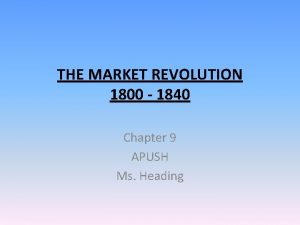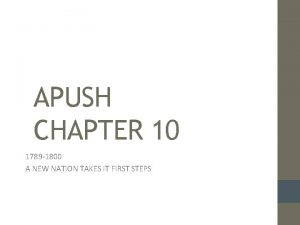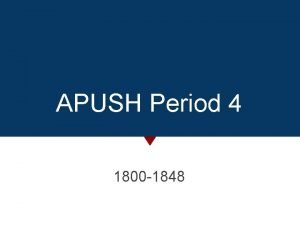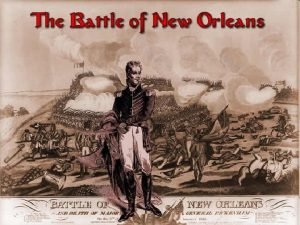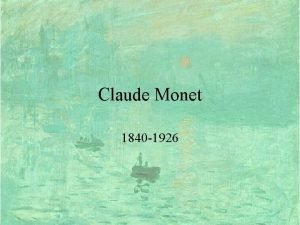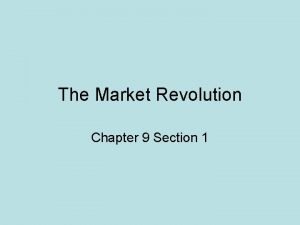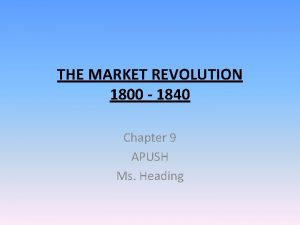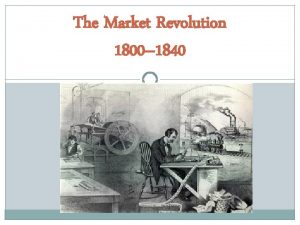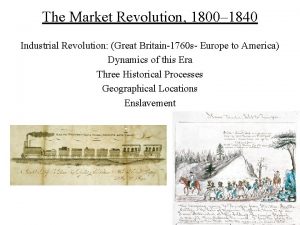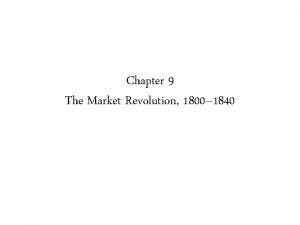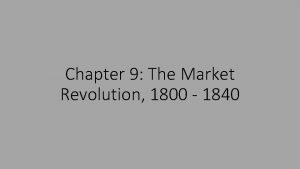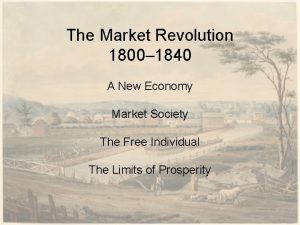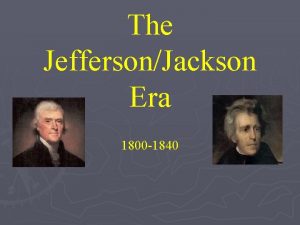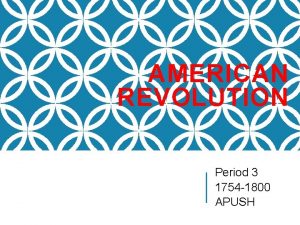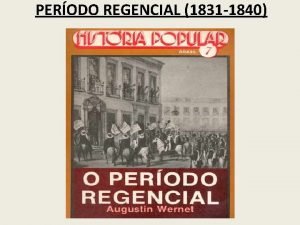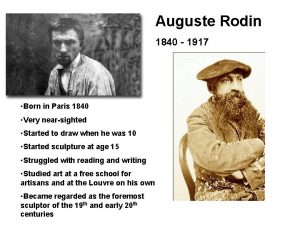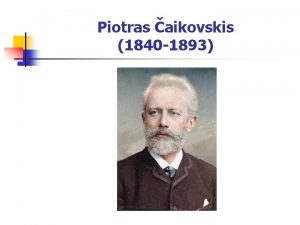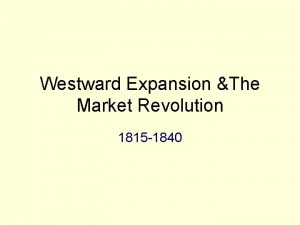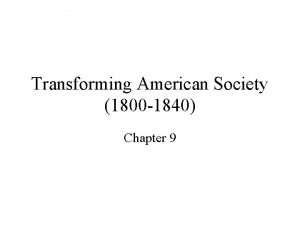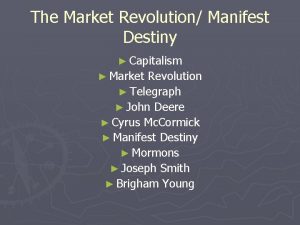THE MARKET REVOLUTION 1800 1840 Chapter 9 APUSH





























































- Slides: 61

THE MARKET REVOLUTION 1800 - 1840 Chapter 9 APUSH Ms. Heading

ACTIVITY DIRECTIONS: • Create a chart with 6 columns labeled transportation, communication, westward movement, agriculture, manufacturing, and immigration to take brief notes as you read through. Use the chart to help organize your thoughts in response to the questions. A sample of the chart is on the back of your chapter 9 key term handout. • Read the following slides to complete your chart, then respond to the 2 question in paragraph form. Write on a separate sheet of paper and use complete sentences. Be sure to use examples to support your response. QUESTION 1: • Identify and explain how innovations in transportation and communication impacted markets, the movement of goods and people, and expansion west between 1800 and 1840. QUESTION 2: • Identify and explain how westward movement, agriculture, manufacturing, and immigration transformed the United States in the early 1800’s. Be prepared to share your responses.

Impact of the Market Revolution • In the 1830 s & 1840 s, territorial & technological growth led to important changes in America: – – – Improved transportation & communication Rapid technological innovation A growing national economy Mass European immigration Desire for transcontinental expansion (“Manifest Destiny”)

Statistics: US expands • 1784 • 1824 • 2014 Population: 4 million Population: 12 million Population: 319 million State: 13 States: 24 States: 50

Market Revolution • Market Revolution was stimulated by: 1. Growth of Markets 2. Westward Movement • 1. 2. 3. Freedom Means: Economic Opportunity Physical Mobility Civic Participation (voting)

Prior to the Market Revolution (pre 1800) Farm families in the West were isolated and self-reliant up to 1800. • Abraham Lincoln's family hunted for food and sewed their own clothes. As an adult, he helped the Illinois Central Railroad connect farmers to markets. Previous Capabilities at the dawn of the 19 th Century (1800's): • roads were rutted paths • flat boats used to move goods on rivers • physical barriers in West • Cost of transporting goods expensive --> 30 miles by road and shipping to England cost the same

An 1810 advertisement for a stagecoach route linking Boston and Sandwich, Massachusetts, reveals the slow speed and high cost of land transportation in the early nineteenth century. It took the entire day (starting at 5 am), and cost around $50 in today’s money to travel the 57 miles between the towns, with stops along the way for breakfast and lunch.

An 1837 copy of a color drawing that accompanied a patent application for a type of raft designed in 1818. For many years, rafts like this were used to transport goods to market on western rivers.

The Market Revolution included a series of innovations related to transportation and communication. Roads • Turnpikes – 1 st advance in overland transportation, also known as toll roads, but locals built detours to avoid the toll (“shunpikes”) • National Road 1806 – 1838, 1 st federal transportation project from Cumberland, MD to the Old Northwest (Michigan, Wisconsin, Indiana, Illinois, Ohio), it reached Wheeling (WV) in 1818

Cumberland (National Road)

The Market Revolution included a series of innovations related to transportation and communication. Steamboats • http: //xroads. virginia. edu/%5 C~HYPER/DETOC/transport/steamboats. html • Canals and Steamboats increased the speed of commerce and lowered the expense of commerce in the 1 st half of the 19 th century. • Robert Fulton's steamboat, the Clermont, made upstream commerce possible and made trade more efficient, helped connect the West with Northern markets - 1807 Clermont traveled upstream from NYC to Albany • 1811 – 1 st Steamboat on Mississippi River

Steamboats & Canals • Mississippi & Ohio Rivers helped farmers get their goods to the East but there was no way to get manufactured goods to the West: – Fulton’s invention of steamboats helped connect the West with Northern manufacturing – State-directed canal projects cut shipping costs by 90% between the West & the North

Robert Fulton’ s Steamboat The Clermont

Canals an artificial waterway constructed to allow passage of boats or ships inland Erie Canal -completed in 1825 Read Background and check out Images under link “Erie Canal Images”: http: //www. eriecanal. org/ • 363 miles • Located in northern New York (goods move between NYC and Great Lakes) • longest canal in the US • Canal attracted farmers and Rochester, Buffalo, and Syracuse developed as a result • canal gave New York primacy over competing ports in accessing trade with the Northwest

A view of New York City, in 1849, by the noted lithographer Nathaniel Currier. Steamships and sailing vessels of various sizes crowd the harbor of the nation’s largest city and busiest port.

A watercolor from 1830 depicts the Erie Canal five years after it opened. Boats carrying passengers and goods traverse the waterway, along whose banks farms and villages have sprung up.

The Erie Canal (1825) provided the 1 st link between East & West The Erie Canal made New York City the commercial capital of the U. S.

Map 9. 1 The Market Revolution: Roads and Canals, 1840: The improvement of existing roads and building of new roads and canals sharply reduced transportation times and costs and stimulated the growth of the market economy.

Railroads & Telegraph • Railroads stimulate mining of coal and production of iron • B&O Railroad was first commercial railroad – 1828 • By 1860, the railroad network had grown to 30, 000 miles • Telegraph - Samuel F. B. Morse, NYC, invented in 1830's, commercial use in 1844 - Telegraph speeds of the flow of information - Improved transportation and communication supported the movement of people west • Read the background and watch the 3 minute video: http: //www. history. com/topics/inventions/telegraph

The Railroad • From 1840 to 1860, the greatest new transportation advance was the expansion of railroads – In 1840 s, railroads began to challenge canals’ dominance – Stimulated industrial & commercial agricultural growth – Led to new forms of finance, such as “preferred stock” & state & local gov’t subsidies

An 1827 engraving designed to show the feasibility of railroads driven by steam powered locomotives, and dedicated to the president of the Baltimore and Ohio Railroad, which began construction in the following year. The engraver placed passengers as far from the locomotive as possible to ensure their safety in case of an explosion.

Transportation Revolution by 1840: Rivers, Roads, Canals, & Railroads

Map 9. 3 Travel times from New York City in 1800 and 1830: These maps illustrate how the transportation revolution of the early 19 th century made possible much more rapid travel within the US

Inland Freight Rates

The Market Revolution: Westward Movement, Agriculture, Manufacturing, and Immigration • Better transportation and communication acceleration western settlement: - 1790 – 1840 4. 5 million crossed Appalachian Mountains - Post War of 1812: 6 states entered Union (Indiana, Illinois, Missouri, Alabama, Mississippi, Maine) * All states but Maine were West of the Appalachian Mountains

The Market Revolution: Westward Movement • Settlers traveled in groups and cooperated as they traveled, cleared land, and built homes. • Donner Party – (do not explore the links if you are sensitive to dark tales and horror) 1846 the Donner Family left for California and split from the main party to take a shortcut. Due to unexpected snow and a treacherous shortcut, this family resorted to canibalism to survive the harsh conditions. Background: http: //www. pbs. org/wgbh/americanexperience/features/introduction/donner-introduction/ Map of Trail and Notes about Journey: http: //www. pbs. org/wgbh/americanexperience/features/map-widget/donner-map/

The Market Revolution: Westward Movement Settlement: • Squatters – western settlers often settled land without buying it (no legal title) • Federal Government – sell land for $1. 25/ acre • Private Land Sales – some settlers bought land on credit Culture: • Migrants brought their culture to the West. • Upstate NY & Upper Northwest resembled New England with small towns, churches, schools • Lower South brought the plantation and slave culture with it

Florida • Americans migrated into areas outside national boundaries. Florida is an example of this. American acquisition of Florida from Spain: https: //history. state. gov/milestones/1801 -1829/florida • 1810, American residents in West Florida seize Baton Rouge • George and Alabama planters want to eliminate FL as a refuge for fugitive slaves • 1818, Andrew Jackson invaded and his men killed British agents and Indian chiefs • Spain realized it was unable to defend the area and finally sold it to the US in the Adams-Onis Treaty, 1819

The Market Revolution: Westward Movement & Agriculture COTTON KINGDOM Market Revolution + Westward Expansion led to sectionalism: • North – Industrialized • South – King Cotton, agriculture, (lack factories) Textiles was the 1 st industry to be shaped by the large factory system , which created a significant demand for cotton

The Market Revolution: Westward Movement & Agriculture COTTON KINGDOM Eli Whitney 1793, • invented the cotton gin http: //www. uh. edu/engines/epi 127. htm • It easily removed seeds from the cotton plant • this facilitated the ability of large scale production of cotton (old process of hand picking seeds was tedious and slow) - Cotton Gin and Movement West (available land for planting) led to the demand for slavery (many thought it would die out)

Eli Whitney’s Cotton Gin, 1793 Actually invented by a slave!

Map 9. 4 The Market Revolution : the spread of cotton cultivation, 1820– 1840: Maps of cotton production graphically illustrate the rise of the Cotton Kingdom stretching from South Carolina to Louisiana.


The Market Revolution: Westward Movement • • • Slavery in the West 1800 – 1860 1 million slaves moved from older slave states to the Deep South (beyond coastal regions) Slave Traders brought slaves West and to auctions Slave Coffles – groups chained to one another on forced marches Westward migration hurt slaves because it separated families, broke up communities Agrarian, slave-based society reproduced itself as settlers went west

Slave Trader, Sold to Tennessee, a watercolor sketch by the artist Lewis Miller from the mid-1850 s. Miller depicts a group of slaves being marched from Virginia to Tennessee. Once Congress voted to prohibit the further importation of slaves into the country, slaveowners in newly opened areas of the country had to obtain slaves from other parts of the United States

The Market Revolution: Westward Movement & Agriculture SLAVERY IN THE WEST • Cotton became the most important export in the US by the middle of the 19 th century: • South’s transportation and banking systems remained adjuncts of the plantation economy • Banks finance purchase of slaves, land, transportation of cotton Cotton Production: (1793 Cotton Gin) • 1793 5 million pounds • 1820 170 million pounds 1860 - South is 80% rural

The Market Revolution: Agriculture • • COMMERCIAL FARMERS Farmers commercialize by growing crops they could sell in markets established by better transportation, roads, and communication Commercialized farmers were financed by banks in the east John Deere's Steel Plow – 1837, made to cut tough prairie ground, easier to till larger quantities of soil, 1855 (sold over 10, 000 per year), 1868 (incorporated) Cyrus Mc. Cormick's reaper – 1831, a horse drawn machine that harvested crops, made it quicker and easier to harvest wheat (wheat - mostly consumed domestically) that once required the work of many farmers, increased crop yields, decreased time to harvest - 1870 (sold more than 10, 000 per year)

Lagonda Agricultural Works, a color lithograph from 1859 advertising an Ohio manufacturer of agricultural machinery, in this case a horse-drawn reaper.

John Deere & the Steel Plow

Cyrus Mc. Cormick & the Mechanical Reaper

The Market Revolution: Westward Movement & Manufacturing The Growth of Cities • Cincinnati - Porkopolis (100, 000 + pigs slaughtered per year) Background on Porkopolis - http: //www. frontdoor. com/places/porkopolis-cincinnatis-pork-producing-past • Chicago - railroad made 4 th largest city by 1860 Images of Historic Chicago - http: //forgottenchicago. com/features/railroads-and-chicago-swing-bridges/ Skim some background info. on Chicago - http: //www. history. com/topics/chicago

A painting of Cincinnati, self-styled Queen City of the West, from 1835. Steamboats line the Ohio River waterfront.

The Market Revolution: Manufacturing Factory System • Samuel Slater - immigrant from England, established America's 1 st factory in 1790 (Pawtucket, RI) he built spinning jenny from memory (illegal to export plans for machinery in Britain) • Outwork System - rural men and women take in work for factories BUT the Market Revolution brought about the factory system of labor Example: Yarn (produced with spinning jenny), sent out to hand-loom weavers to make cloth • Factory System of labor – factory workers began to replace skilled artisan – less and less skills needed – strict supervision in factories – tasks broken down (simplified)

A group of shoemakers with their tools, photographed in 1837. Artisan production survived in many crafts, but shoemakers found themselves in dire straits as factories began industrializing shoe production.

Mill on the Brandywine, an 1830 watercolor of a Pennsylvania paper mill. Because it relied on water power, much early manufacturing took place in the countryside.

The Market Revolution: Manufacturing • Waltham, Massachusetts 1814 - 1 st large-scale American factory built by Boston Associates - utilize power looms • Embargo act of 1807 and War of 1812 sparked the large-scale factory in Mass. due to the cutoff of British imports • Lowell, Massachusetts – 1850, 52 mills, more than 10, 000 workers • Steam Power meant that factories did not need to be near the "fall Line" or by waterfalls to generate energy and could develop in other cities Fall Line factories: (Pawtucket, Waltham, Lowell) Steam Power factories: (New Bedford, Philadelphia, Chicago) • "American System of manufacturers" owed its development to Eli Terry's interchangeable parts used in clockmaking allowed easily assembly of goods

Samuel Slater (“Father of the Factory System”)

Elias Howe & Isaac Singer 1840 s Sewing Machine

• • The Market Revolution: Manufacturing & Immigration Industrial Worker Time: Farm life regulated by the seasons Factory life regulated by clocks Clocks increasingly regulated the separation of work and leisure time "Wage" rather than "Price" used to define factory workers payment (Price was used for artisans pay based on goods produced) Factory work attracted many immigrants because native born Americans felt work determined by a clock at a machine all day violated their independence

A broadside from 1853, illustrating the long hours of work (12 hours per day, with 30 minutes for lunch) in Lowell mills and the way factory labor was strictly regulated by the clock.

The Market Revolution: Manufacturing Lowell Mill Girls Background: http: //www. nps. gov/lowe/planyourvisit/upload/mill%20 girls. pdf Video: http: //www. youtube. com/watch? v=pk. Jw. OYagvu. I (you tube video, access from home) • Young unmarried women from the North • "Yankee farm women" dominated workforce prior to the early 1850's • Supervision : (parents needed to be comfortable with letting their daughters leaven the home to work), at Lowell boarding houses, strict rules, lecture halls, churches, and worker-edited periodicals established to occupy free time • Women eventually went home to marry or move west (many were temporary young workers)

Lowell Boarding Houses The Lowell System: The 1 st Dual-Purpose Textile Plant Francis Cabot Lowell’s town - 1814

Women at work tending machines in the Lowell textile mills.

A photograph from around 1860 of four anonymous working women. Their stance and gaze suggest a spirit of independence.

The Market Revolution: Immigration Mass Immigration Begins Background: http: //www. ushistory. org/us/25 f. asp • From 1840 & 1860, 4 million Irish & Germans immigrated to America • Motivations for immigration: – Most came for higher wages in northern industrial jobs – The potato blight from 1845 -1854 brought 1. 5 million Irish immigrants – Low fares on trans-Atlantic ships made access easier

The Market Revolution: Immigration Growth of Immigration Video (3 minutes): http: //www. youtube. com/watch? v=8 -s_w. Mj. Bl-k • 1840 - 1860: over 4 Million people enter US (more than pop. in 1790) • Majority of immigrants (1840 - 1860) were German and Irish • Great Famine of 1845 - 1851 made Irish largest number of immigrants • Irish filled low-wage factory jobs (4/5 ths of Irish stayed in Northeast) • Germans (2 nd largest number of immigrants) were skilled craftsmen • "German Triangle" (Cincinnati, OH; St. Louis , MO; Milwaukee, WI) - had large, tight knit German communities

Figure 9. 1 Sources of Immigration

Although our image of the West emphasizes the lone pioneer, many migrants settled in tightly knit communities and worked cooperatively. This painting by Olof Krans, who came to the US from Sweden with his family in 1850 at the age of 12, shows a groups of women preparing to plant corn at the immigrant settlement of Bishop Hill, Illinois.

The Market Revolution: Immigration Nativism • blamed immigrants (1840's) for urban crime, alcohol abuses, undercutting wages, political corruption - labeled Irish: childlike, lazy - Irish Catholics generated significant hostility due to their connection to "popery" • Archbishop John Hughes, NYC, asserted Catholicism and conversion • Urban Political Machines (Democratic Party) connected the Irish to jobs for their vote

The Market Revolution: Immigration Anti-Immigrant Reaction: • Immigrant groups were met with prejudice (especially the Irish Catholics) 1840 s & 1850 s • Nativism emerged among American-born citizens: – Suspicion of the new ethnic neighborhoods & alien cultures – Led to bloody anti-Catholic riots, charges of despotism, & anti-Irish propaganda Riots : http: //philadelphiaencyclopedia. org/archive/nativist-riots-of-1844/

The Market Revolution: Business & Law Transformation of Law • Corporations become central in new market economy ( a form of business with shareholders) – Corporation granted special privileges and powers through a government charter – Advantages - investors and directors not personally liable for company's debts, easily raise capital – Americans distrust corporations (lack of liability for damage of property. . . ) – Courts supported employer authority over workplace and right to punish workers for a strike until 1842, Commonwealth v Hunt, Massachusetts court say workers have right to organize Gibbons v. Ogden - Supreme Court struck down a monopoly the NY legislature granted for steamboat navigation (between NY and NJ) http: //www. pbs. org/wnet/supremecourt/antebellum/landmark_gibbons. html
 Peaceful coexistence apush
Peaceful coexistence apush Steamboat apush
Steamboat apush Market revolution apush
Market revolution apush 1754 to 1800 apush
1754 to 1800 apush 1789 apush
1789 apush 1800 apush significance
1800 apush significance Fired our guns and the british kept coming
Fired our guns and the british kept coming Voto censitário
Voto censitário England v davidson (1840)
England v davidson (1840) Liebig 1840
Liebig 1840 Segundo reinado 1840 a 1889
Segundo reinado 1840 a 1889 Fue descubierto y nombrado por schoenbein en 1840
Fue descubierto y nombrado por schoenbein en 1840 Claude monet snídaně v trávě
Claude monet snídaně v trávě Market leader challenger follower nicher
Market leader challenger follower nicher Requirements for effective segmentation
Requirements for effective segmentation Chapter 9 section 1 the market revolution
Chapter 9 section 1 the market revolution Chapter 12: religion, romanticism, and reform, 1800–1860
Chapter 12: religion, romanticism, and reform, 1800–1860 Russian revolution vs french revolution
Russian revolution vs french revolution Could the french revolution have been avoided
Could the french revolution have been avoided Green revolution vs third agricultural revolution
Green revolution vs third agricultural revolution Market revolution immigration
Market revolution immigration Dorothea lange apush
Dorothea lange apush Hình ảnh bộ gõ cơ thể búng tay
Hình ảnh bộ gõ cơ thể búng tay Slidetodoc
Slidetodoc Bổ thể
Bổ thể Tỉ lệ cơ thể trẻ em
Tỉ lệ cơ thể trẻ em Gấu đi như thế nào
Gấu đi như thế nào Thang điểm glasgow
Thang điểm glasgow Bài hát chúa yêu trần thế alleluia
Bài hát chúa yêu trần thế alleluia Môn thể thao bắt đầu bằng chữ đua
Môn thể thao bắt đầu bằng chữ đua Thế nào là hệ số cao nhất
Thế nào là hệ số cao nhất Các châu lục và đại dương trên thế giới
Các châu lục và đại dương trên thế giới Cong thức tính động năng
Cong thức tính động năng Trời xanh đây là của chúng ta thể thơ
Trời xanh đây là của chúng ta thể thơ Cách giải mật thư tọa độ
Cách giải mật thư tọa độ 101012 bằng
101012 bằng Phản ứng thế ankan
Phản ứng thế ankan Các châu lục và đại dương trên thế giới
Các châu lục và đại dương trên thế giới Thể thơ truyền thống
Thể thơ truyền thống Quá trình desamine hóa có thể tạo ra
Quá trình desamine hóa có thể tạo ra Một số thể thơ truyền thống
Một số thể thơ truyền thống Cái miệng xinh xinh thế chỉ nói điều hay thôi
Cái miệng xinh xinh thế chỉ nói điều hay thôi Vẽ hình chiếu vuông góc của vật thể sau
Vẽ hình chiếu vuông góc của vật thể sau Biện pháp chống mỏi cơ
Biện pháp chống mỏi cơ đặc điểm cơ thể của người tối cổ
đặc điểm cơ thể của người tối cổ Ví dụ giọng cùng tên
Ví dụ giọng cùng tên Vẽ hình chiếu đứng bằng cạnh của vật thể
Vẽ hình chiếu đứng bằng cạnh của vật thể Vẽ hình chiếu vuông góc của vật thể sau
Vẽ hình chiếu vuông góc của vật thể sau Thẻ vin
Thẻ vin đại từ thay thế
đại từ thay thế điện thế nghỉ
điện thế nghỉ Tư thế ngồi viết
Tư thế ngồi viết Diễn thế sinh thái là
Diễn thế sinh thái là Dạng đột biến một nhiễm là
Dạng đột biến một nhiễm là So nguyen to
So nguyen to Tư thế ngồi viết
Tư thế ngồi viết Lời thề hippocrates
Lời thề hippocrates Thiếu nhi thế giới liên hoan
Thiếu nhi thế giới liên hoan ưu thế lai là gì
ưu thế lai là gì Hổ đẻ mỗi lứa mấy con
Hổ đẻ mỗi lứa mấy con Sự nuôi và dạy con của hươu
Sự nuôi và dạy con của hươu Hệ hô hấp
Hệ hô hấp


